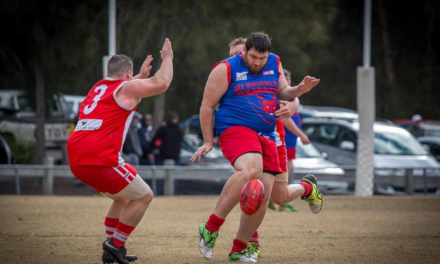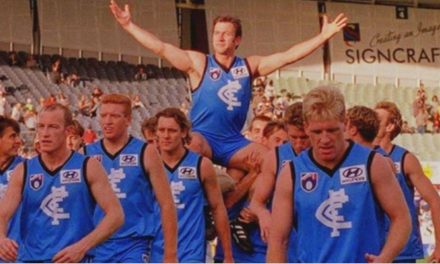Port Adelaide might have avoided having to use Jackson Trengove (left) in the ruck in 2016 had there been a mid-season draft. Photo: GETTY IMAGES
Mid-season draft might just be an idea with some merit
When AFL chief executive Gillon McLachlan recently flagged the introduction of a mid-season trade period in the near future, reaction was mixed, to say the least.
While some fans on social media seemed open to the idea, many were furious at the suggestion, seeing it as another unnecessary change that would ‘Americanise’ the league and further erode club loyalty.
But while many AFL fans and clubs are reluctant for change, a mid-year trade period – if implemented correctly – is a worthwhile endeavour which could dramatically improve both player movement and the convoluted AFL calendar.
Since the introduction of free agency at the end of the 2012 season, player movement has become much more fluid, but McLachlan thinks even greater movement between clubs through mid-year trading would benefit struggling sides.
“I would like to see [a mid-year trade period] because it’s the only times… where you have the weaker clubs lower down the ladder having more leverage in the trade,” McLachlan told an AFL Media podcast.
“It’s four, five or six years for a club to get in the position to be competing deep into the finals. And you might get the wrong couple of injuries, and you’ve got everything right and you’re travelling well, and you need a player [and you have] the ability to trade mid-season to pick up a key defender or ruckman.”
McLachlan suggested that mid-year trading could allow a competing club in need of a replacement to pay a struggling club quite generously for a desired player.
“The best example was two years ago Port were out of ruckmen [because] Paddy Ryder unexpectedly was rubbed out for the year and [Matthew] Lobbe did his knee, or something, and they ended up having [Jackson] Trengove rucking.
“St Kilda, as an example, had four or five ruckmen, weren’t competing for the eight, I’m sure they had something Port Adelaide needed. That would’ve been an opportunity and St Kilda would have had the leverage.”
But besides this obvious benefit explained by the AFL boss, another reason a mid-season draft could be useful is to address some of the frustrations with the current AFL calendar.
The end-of-season trade period has become bloated, with an almost two-week trade window facilitating drawn-out negotiations between clubs refusing to budge until the last second.
Reducing end-of-year trading to one week would not hinder the ability for clubs to make a trade, but it would force list managers to secure deals with greater urgency. This is something all fans would appreciate.
To offset the reduction in trading opportunities post-season, a one-week mid-season draft could be introduced during the bye round.
Currently the bye is held over three weeks, throwing the season out of whack with an extended period of reduced football.
If the bye was held over just one week of no football, the void could be filled with mid-season trading.
This would ensure public interest in the AFL remains, while clubs receive the same period to rest and refresh for the second half of the season.
It would also mean that any players who have mentally checked-out from a club mid-year can be off-loaded without waiting until the end of the year to be traded.
Out-of-contract players who face intense scrutiny during the year to re-sign would also be given the option to leave their club early, and reduce some of the mental stress this speculation can cause.
A lot of AFL fans would find it difficult to see a player pull on another jumper mid-season, but whether you like it or not, it is the direction the game is now heading in. And it’s not like mid-season player movement is completely new to the league, with four mid-year drafts taking place from 1990 to 1993.
This was not particularly successful at the time, and it was used mainly as a vehicle to recruit AFL players from lower leagues, rather than to recruit talent from other clubs.
Phil Krakouer was one of the few high-profile players to move clubs in this draft, going from North Melbourne to Footscray in the 1990 mid-season draft.
But he only went on to only play seven games at the Dogs after 141 with North Melbourne (in fact he didn’t play a game in 1990 and debuted for Footscray the next year).
A mid-season trade period these days, however, would be completely different and has the potential to be a game-changer for the league.
The larger appetite for player movement now bodes well for its future success and as McLachlan noted, no clubs would be forced to participate in trading if they didn’t wish to.
As with the mid-season draft, it is not a concept that needs to be set in stone, but it is surely worth trialling to address some of the existing issues surrounding the bye and the trade period.
And for the inevitable few clubs who succumb to an injury curse each year, some astute mid-year trading might be just the tonic to reinvigorate a season that would otherwise slip away.











